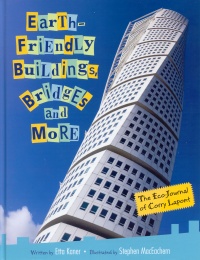| ________________
CM . . .
. Volume XVIII Number 33. . . .April 27, 2012 
 |
Earth-Friendly Buildings, Bridges and More: The Eco-Journal of Cory LaPont.
Etta Kaner. Illustrated by Stephen MacEachern.
Toronto, ON: Kids Can Press, 2012.
64 pp., hardcover, $19.95.
ISBN 978-1-55453-570-5.
Subject Headings:
Sustainable architecture-Juvenile literature.
Urban ecology (Sociology)-Juvenile literature.
Grades 3-6 / Ages 8-11.
Review by Gillian Richardson.
**** /4
|
| |
|

excerpt:
When a tunnel must travel deeper (as under building or waterways), it is dug with a tunnel boring machine (TBM).
TBMs are also used to tunnel through mountains. These machines are enormous! They can be as long as four football fields laid end to end and as tall as a five-story building. The front of the TBM is like a giant tin can with a huge cutting wheel at its front. When the TBM pushes forward, the cutting wheel rotates and grinds down the rock. The chewed up rock falls through spaces in the wheel onto a conveyor belt, which carries it to rail cars on a track inside the tunnel. The rail cars carry the muck out of the mountain.
TBMs build supports for the tunnel walls at the same time as they bore the tunnel. A machine behind the cutting wheel places either steel mesh or steel rings along the tunnel walls. Then a robot sprays shotcrete (sticky concrete) from a hose onto the steel supports to line the tunnel.
If you think a discussion of design, architecture and construction of skyscrapers, bridges, tunnels, domes, dams, dikes, levees and locks could be a dry topic for kids, you’ll want to see this book’s imaginative approach. In Earth-Friendly Buildings, Bridges and More, readers will be introduced to some of the world’s newest and most innovative structures as displayed in a scrapbook created by a fictitious 12-year-old, Corry LaPont, who travels with her engineer parents.
In Corry’s voice, the author examines each type of structure especially for its ‘green’ design and environmental impact. She introduces various careers in engineering and architecture while showing the planning and preparation for skyscrapers from foundations, to frames, to earthquake-resistant features. More careers are highlighted with respect to construction of the familiar types of bridges. Tunnels are examined for their diverse uses and the gigantic equipment needed to dig them. Domes – from stadiums to homes – are shown. Different types of dams, dikes and levees around the world, and explanations of how locks work complete the book. Sprinkled throughout the pages you’ll find simple, fun experiments and activities that demonstrate complex scientific principles, such as why skyscrapers need broad bases, how they use cross-bracing for strength, how suspension bridges are anchored and what gives domes their strength. This interactive feature is a clever way to add appeal for the topic.
A well-balanced mix of illustrations and photos gives readers close-up glimpses of many unique modern structures and the components that account for their ‘green’ status. This focus will be of particular interest to today’s young readers who are up on current conservation ideas. For example, skyscrapers might recycle rainwater or provide bicycle parking only. One detail that could have been included is some mention of the latest bird-friendly building designs to mitigate collisions with glass. Ecopassages (they allow animals to cross highways safely) are mentioned, as well as suspension bridges (ecotourist adventures) in rainforests whose construction did not damage trees. Who would imagine a bridge could be built with recycled plastic? An important aspect of tunneling is the research to determine how construction might affect animal habitats, or groundwater sources. An examination of the pros and cons of dams (under the guise of Corry’s participation in a class debate) will offer readers the chance to apply critical thinking. The author has anticipated readers’ questions in dialogue balloons between Corry and her younger brother, Riley.
As Corry muses at the end about possible career choices for herself, so the reader will be inspired to consider some of the fascinating vocations involved with modern design, engineering and construction. Earth-Friendly Buildings, Bridges and More will only whet their appetites and give them many take-off points to further investigation of the topics.
Highly Recommended.
Gillian Richardson is a freelance writer living in BC.

To comment
on this title or this review, send mail to cm@umanitoba.ca.
Copyright © the Manitoba Library Association. Reproduction for personal
use is permitted only if this copyright notice is maintained. Any
other reproduction is prohibited without permission.
NEXT REVIEW |
TABLE OF CONTENTS FOR THIS ISSUE
- April 27, 2012.
AUTHORS |
TITLES |
MEDIA REVIEWS |
PROFILES |
BACK ISSUES |
SEARCH |
CMARCHIVE |
HOME |
